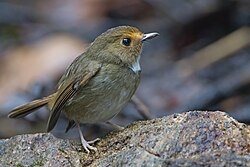| Rufous-browed flycatcher | |
|---|---|
 | |
| Scientific classification | |
| Kingdom: | Animalia |
| Phylum: | Chordata |
| Class: | Aves |
| Order: | Passeriformes |
| Family: | Muscicapidae |
| Genus: | Anthipes |
| Species: | A. solitaris |
| Binomial name | |
| Anthipes solitaris (Müller, 1836) | |
| Synonyms | |
| |
The rufous-browed flycatcher (Anthipes solitaris) is a species of bird in the family Muscicapidae. It is native to Indonesia, Laos, Malaysia, Myanmar, Thailand and Vietnam. Its natural habitat is subtropical or tropical moist montane forests. It was formerly placed in the genus Ficedula . [1]
